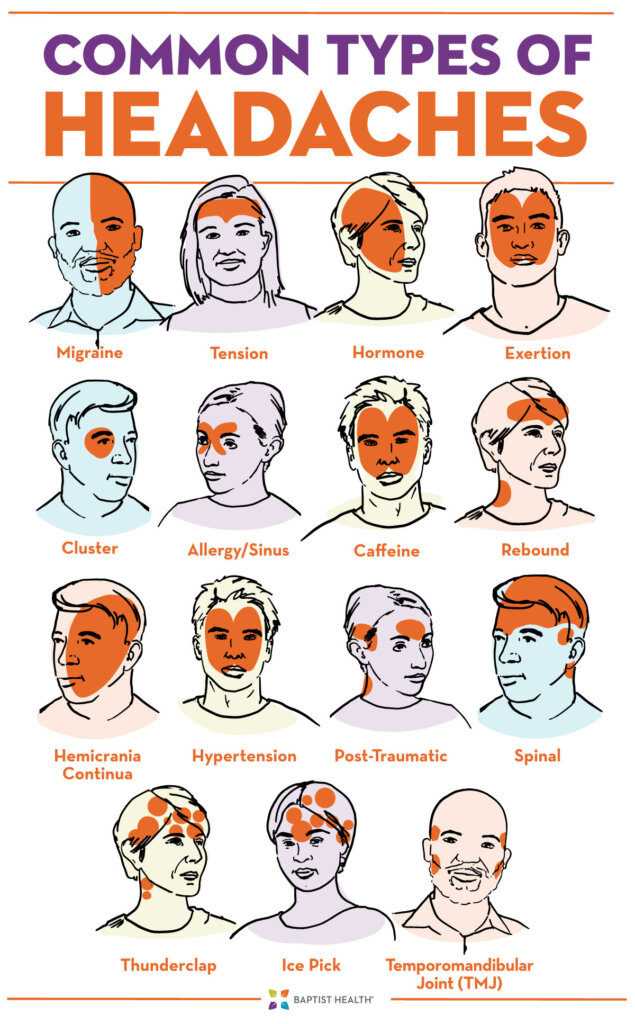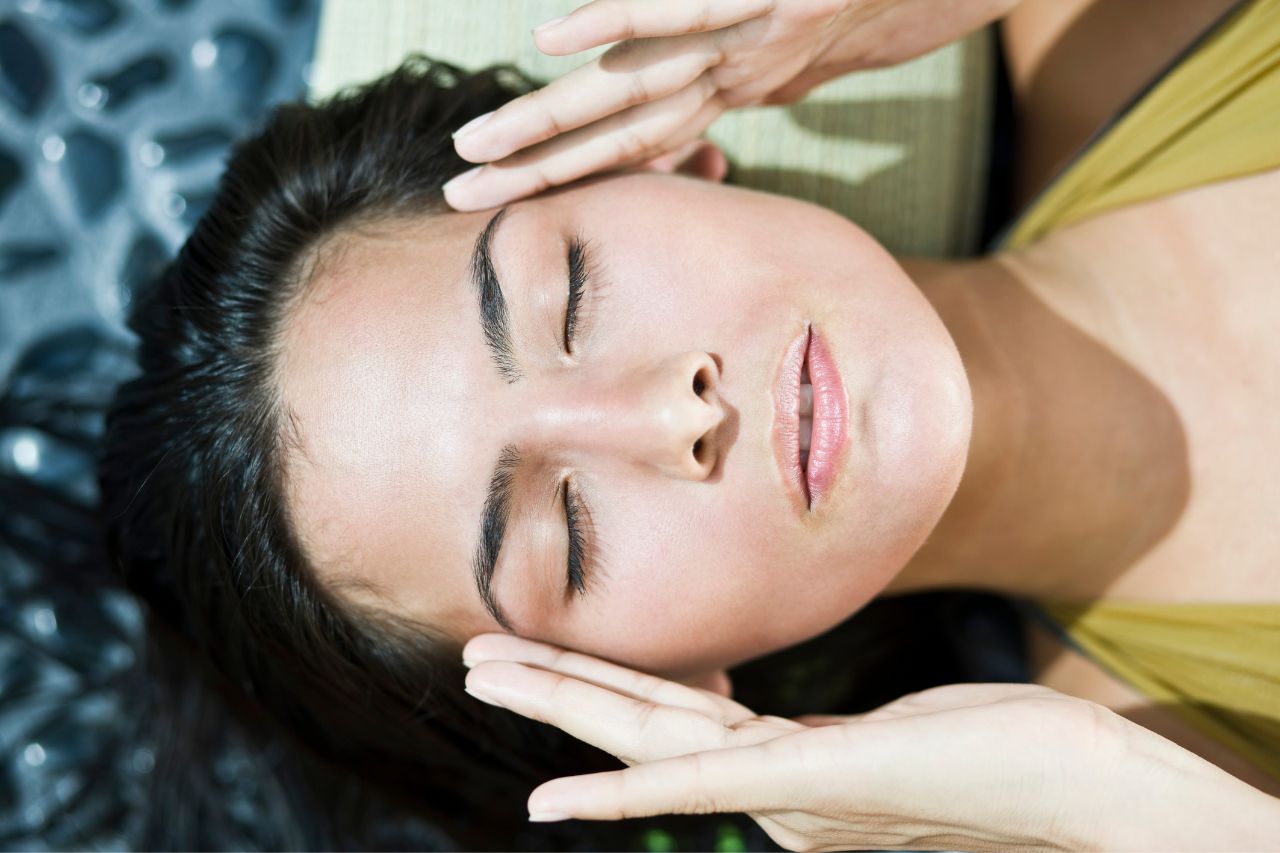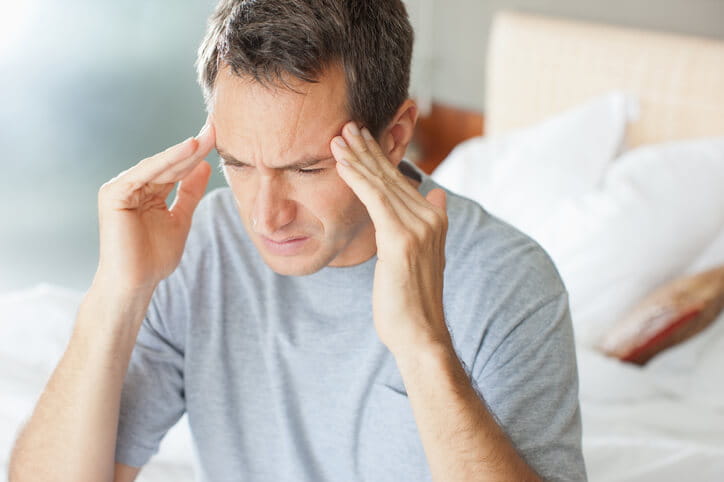Common Types of Headaches

It’s normal to have an occasional headache. Typically, it’s easy to see the cause: sinus infection, fever, allergies, caffeine withdrawal, hunger, hangover, etc. These are temporary conditions you can alleviate with over-over-the-counter pain relievers, rest, and hydration.
However, if you have more persistent headaches, that can be more problematic, especially if they put you “out of commission” for a significant time. And recurring headaches can indicate an underlying or chronic condition that should be addressed.
Headache Types
There are several types of headaches. Some of the most common are:
- Migraine headaches
- Tension headaches
- Hormone headaches
- Exertion headaches
- Cluster headaches
- Allergy/sinus headaches
- Caffeine headaches
- Rebound headaches
- Hemicrania continua headaches
- Hypertension headaches
- Post-traumatic headaches
- Spinal headaches
- Thunderclap headaches
- Ice pick headaches
- Temporomandibular joint (TMJ) headaches
Doctors use various characteristics to categorize and diagnose headaches, including pain location, pain type (dull, sharp, etc.), cause, and others. However, beyond addressing any underlying condition, the treatment is similar for each and includes pain relievers and rest.

Migraine headaches
Migraine headaches produce intense, throbbing pain experienced deep in your head and often on one side. They can resolve relatively quickly or last for days. Migraine headaches may be preceded by visual disturbances (an aura) and cause nausea, vomiting, and sensitivity to sound and light.
Triggers include hormonal changes, dehydration, sleep disruption, certain foods, and chemical exposure.
Tension headaches
People typically experience tension headaches as a dull, aching pain distributed all over their head. They may also have tenderness in their shoulder muscles, neck, scalp, and forehead.
The most common trigger is stress.
Hormone headaches
Hormone headaches are more common in women and are associated with hormone fluctuations due to menstruation, pregnancy, and using birth control pills — all of which can affect estrogen levels.
When hormone headaches occur in sync with a woman’s menstrual cycle, they’re called menstrual migraines.
Exertion headaches
These headaches, which people typically experience as throbbing on the sides of their head, follow periods of exertion, such as intense exercise, sex, and other physical activities. Experts believe that the effort increases blood flow to the skull and triggers a headache.
Tension headaches typically persist for a few minutes to several hours.
Cluster headaches
Cluster headaches cause intense, piercing pain and a burning sensation behind one eye or on one side of the face. The word “cluster” is used in the name because these headaches typically happen multiple times in a day, often around the same time. They may also cause drooping eyelids, nasal congestion or drainage, sound and light sensitivity, pale, sweaty skin, redness of the eyes or face, and restlessness.
Cluster headaches are three times more common in men and are more likely to occur in the spring and fall.
Allergy/sinus headaches
These headaches are caused by an allergic reaction, with the pain developing in an X shape centered on the bridge of the nose and extending above and below the eyes. If you have seasonal allergies or chronic sinusitis, you’re more likely to develop this type of headache.
Migraine headaches are commonly misdiagnosed as sinus headaches.
Caffeine headaches
Having too much caffeine at one time or stopping your caffeine intake abruptly if you consume it regularly can cause headaches. That’s because caffeine affects blood flow to the brain and brain chemistry, and sudden changes can cause disruptions that trigger a headache.
Rebound headaches
Rebound headaches typically result from the overuse of medication. They can produce a dull ache or sharp pain. Taking over-the-counter pain relievers (ibuprofen, acetaminophen, etc.) more than 15 days a month may increase your risk of rebound headaches. Medications containing caffeine can also cause these headaches.
Hemicrania continua headaches
This uncommon headache persists on one side of the head for three months or more. It typically causes pain of moderate intensity with periodic spikes. Women are twice as likely to get hemicrania continua headaches, which may also cause eyelid drooping, nasal congestion, runny nose, eye tearing or redness, pupil constriction, and restlessness.
Hypertension headaches
This type of headache occurs in people with high blood pressure, requiring urgent medical care. These headaches are caused by blood pressure that gets dangerously high. The pain pulsates, typically on both sides of the head, and worsens with activity.
If you or someone with you develops a hypertension headache, go immediately to an emergency room, or call 911.
Post-traumatic headaches
Post-traumatic headaches develop after head injuries. The pain is like tension or migraine headaches and can last a year after the injury. In some instances, these headaches become chronic.
Spinal headaches
Low cerebrospinal fluid pressure following a lumbar puncture causes spinal headaches. Also called postdural puncture headaches, they can produce pain in the temples, forehead, back of the head, and upper neck.
Typical onset is within two or three days after the procedure and may include other symptoms like nausea, visual changes, dizziness, ringing in the ears, hearing loss, neck pain, and pain that radiates into the arms.
Thunderclap headaches
These excruciating headaches come on quickly, reaching peak intensity in less than a minute. They may be harmless or associated with a serious underlying condition like a stroke, brain injury, blood vessel problem, reversible vasoconstriction syndrome (RCVS), vasculitis, or pituitary apoplexy (bleeding from or into an organ).
If you experience a thunderclap headache and have not had one before, you should seek immediate medical attention.
Ice pick headaches
As the name suggests, these headaches produce stabbing pain. It comes in short, intense flares individually or in a series. The headaches may occur multiple times daily. It’s common for the pain to develop in different spots on the head. Pain consistently in one location may indicate an underlying condition.
TMJ headaches
TMJ headaches result from stress, jaw clenching, or a poor bite. Sometimes people with these headaches also experience a painful clicking when they open their jaw. In most instances, TMJ headaches can be treated with relaxation techniques like meditation or yoga and a bite plate. In severe cases, surgery may be needed to correct the bite.
Talk with Your Baptist Health Physician to Understand and Manage Headaches
Minor and infrequent headaches generally aren’t cause for concern. But if you have frequent or intense headaches, you should talk with your doctor.
They can gather information from you, perform an exam, and order tests if needed to diagnose your condition. Then they can prescribe treatment to minimize or eliminate your headache pain. Your doctor may also refer you to a neurologist for specialized treatment.
Next Steps and Useful Resources
Can Allergies Cause Headaches?
The Difference Between Headaches and Migraines
Hormonal Changes and Headaches in Females



